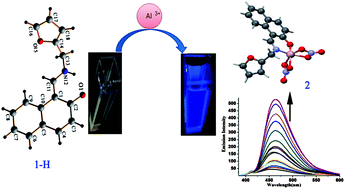A water soluble Al3+ selective colorimetric and fluorescent turn-on chemosensor and its application in living cell imaging†
Abstract
An efficient

* Corresponding authors
a
Department of Chemistry, The University of Burdwan, Golapbag, Burdwan-713104, India
E-mail:
pabitracc@yahoo.com
b Department of Solid State Physics, Indian Association for the Cultivation of Science, Jadavpur, Kolkata 700032, India
c Molecular Biology and Genetics Laboratory, Department of Zoology, The University of Burdwan, Golapbag, Burdwan-713104, India
d Laboratory of Functional Genomics and Proteomics, Institute of Experimental Biology, Masaryk University, Kamenice 5/A2, CZ-625 00 Brno, Czech Republic
An efficient

 Please wait while we load your content...
Something went wrong. Try again?
Please wait while we load your content...
Something went wrong. Try again?
S. Sen, T. Mukherjee, B. Chattopadhyay, A. Moirangthem, A. Basu, J. Marek and P. Chattopadhyay, Analyst, 2012, 137, 3975 DOI: 10.1039/C2AN35560D
To request permission to reproduce material from this article, please go to the Copyright Clearance Center request page.
If you are an author contributing to an RSC publication, you do not need to request permission provided correct acknowledgement is given.
If you are the author of this article, you do not need to request permission to reproduce figures and diagrams provided correct acknowledgement is given. If you want to reproduce the whole article in a third-party publication (excluding your thesis/dissertation for which permission is not required) please go to the Copyright Clearance Center request page.
Read more about how to correctly acknowledge RSC content.
 Fetching data from CrossRef.
Fetching data from CrossRef.
This may take some time to load.
Loading related content
